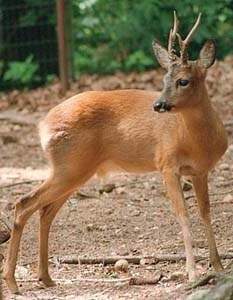Siberian roe deer facts for kids
Quick facts for kids Siberian roe deer |
|
|---|---|
 |
|
| Conservation status | |
| Scientific classification | |
| Kingdom: | |
| Class: | |
| Order: | |
| Family: | |
| Subfamily: |
Odocoileinae
|
| Genus: |
Capreolus
|
| Binomial name | |
| Capreolus pygargus |
|
The Siberian roe deer (Capreolus pygargus), also known as the eastern roe deer, is a type of roe deer. These amazing animals live across a large part of northeastern Asia. You can find them in places like Siberia and Mongolia. They also live in Kazakhstan, the Tian Shan Mountains, Eastern Tibet, the Korean peninsula, and northeastern China.
Contents
About the Siberian Roe Deer
The Siberian roe deer is a medium-sized deer. It is known for its graceful movements. These deer are smaller than many other deer species. They are well-adapted to living in cold climates. They have a thick coat of fur that changes color with the seasons. This helps them blend in with their surroundings.
What They Look Like
Siberian roe deer have a reddish-brown coat in summer. This coat turns a grayish-brown in winter. This color change helps them stay camouflaged. They have a white patch on their rump. This patch is especially noticeable when they are alarmed. Males, called bucks, grow antlers. These antlers are usually small and have three points. They shed their antlers every year, usually in late autumn or early winter. New antlers start growing soon after.
Where They Live
Siberian roe deer live in many different habitats. They prefer areas with a mix of forests and open grasslands. This allows them to find both food and shelter. They can be found in dense forests, woodlands, and even open steppes. They are very good at adapting to different environments. Their wide range shows how tough and flexible they are.
Daily Life and Behavior
Siberian roe deer are mostly active during the early morning and late evening. They are known as crepuscular animals. During the day, they often rest in thick bushes or tall grass. This helps them stay hidden from predators. They are generally shy and cautious animals. They have excellent hearing and a good sense of smell. These senses help them detect danger quickly.
What They Eat
Siberian roe deer are herbivores. This means they only eat plants. Their diet changes with the seasons. In spring and summer, they eat fresh grasses, leaves, and young shoots. They also enjoy berries and mushrooms. In winter, when fresh food is scarce, they browse on twigs, bark, and moss. They are very picky eaters. They choose the most nutritious parts of plants.
How They Communicate
Roe deer communicate in several ways. They use sounds, body language, and scent. When they are alarmed, they make a barking sound. This warns other deer of danger. Males also use scent marks to mark their territory. They rub their antlers on trees and bushes. This leaves behind a scent that tells other deer who is in the area.
Reproduction and Life Cycle
The breeding season for Siberian roe deer usually happens in late summer. This is when males compete for females. After mating, the female carries her young for about 10 months. This long gestation period is unique among deer. It allows the fawns to be born in late spring or early summer. This is when food is plentiful.
Fawns and Growing Up
Female roe deer usually give birth to one or two fawns. The fawns are born with spotted coats. These spots help them blend into the dappled light of the forest. They are very small and helpless at birth. The mother hides her fawns in tall grass or thickets. She visits them several times a day to nurse them. Fawns grow quickly and start eating solid food after a few weeks. They stay with their mother for several months. They learn important survival skills from her.
Conservation Status
The Siberian roe deer is currently listed as a species of "Least Concern" by the IUCN. This means their population is stable. However, they still face some threats. Habitat loss due to human development is one concern. Poaching, which is illegal hunting, can also affect their numbers in some areas. Conservation efforts are important to ensure these beautiful deer continue to thrive in their natural habitats. Protecting their forests and grasslands helps them survive.
Images for kids
See also
 In Spanish: Corzo siberiano para niños
In Spanish: Corzo siberiano para niños



